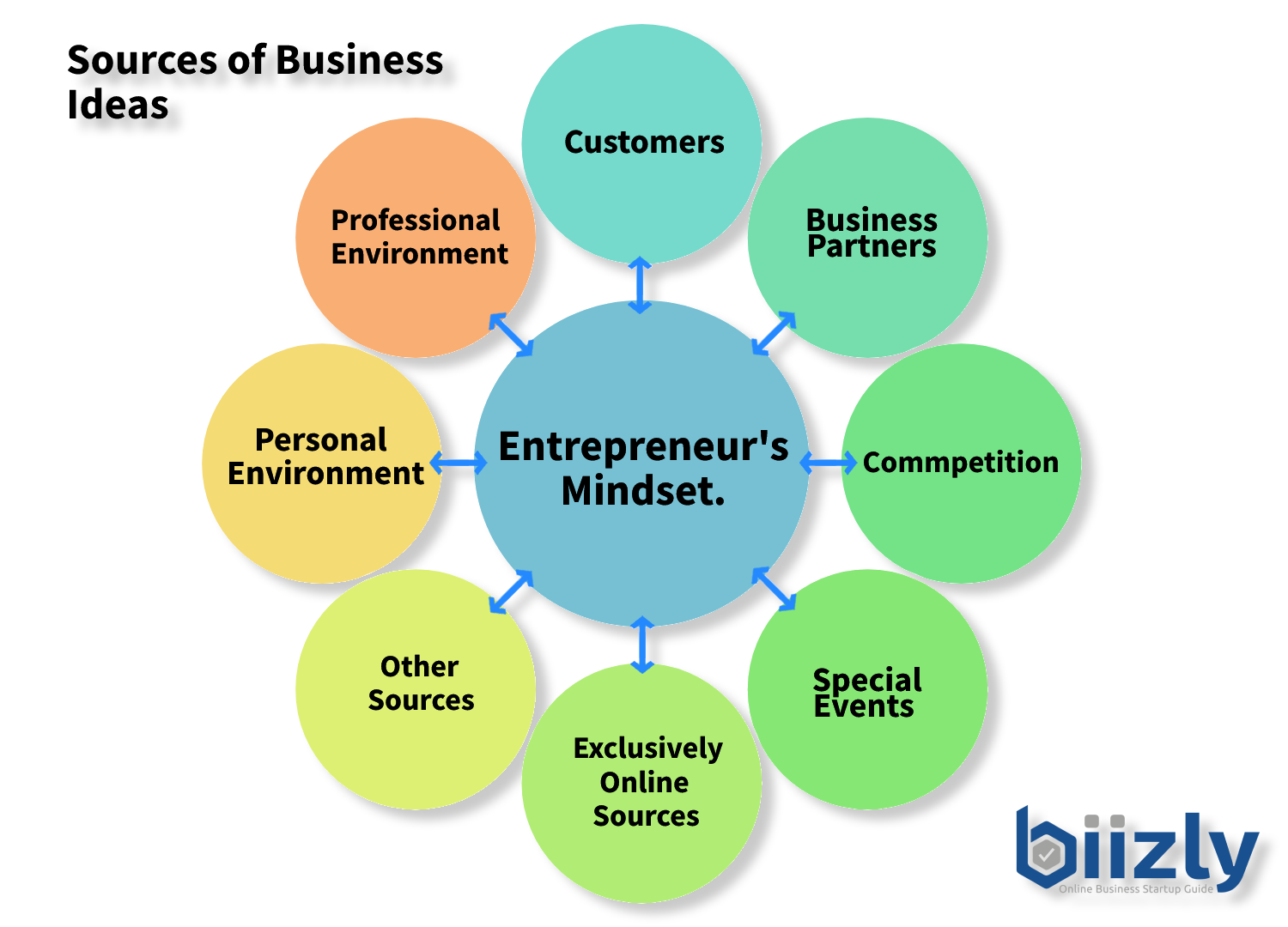A sound business idea is the foundation of any successful business, but where do entrepreneurs find inspiration for such great ideas?
In order to start and run a successful business, entrepreneurs need to be creative, innovative, and constantly searching for new ideas. The truth is that business ideas can spring from an array of sources, and entrepreneurs must be able to recognize and seize opportunities when they arise.
Sources of Business Ideas
There are many different sources of business ideas, ranging from personal cognition to market research. So, let’s explore the variety sources that can help entrepreneurs identify and capitalize on opportunities in the market.

Entrepreneur’s Mindset.
The entrepreneur’s cognition, based on his/her experience, knowledge, and creativity, can be considered as essential and the most important source for generating business ideas. Entrepreneurs often draw on their own skills, expertise, and knowledge to identify business opportunities. This could be a result of their experience working in a particular industry or profession, or it could be a product of their own creativity, unique talents and interests.
The entrepreneur’s mindset is also needed to search, recognize and adopt ideas from external sources too. The additional sources only strengthen the foremost capacity of the entrepreneur to generate or accept potentially successful business ideas. The entrepreneurial mindset also represents the alertness and openness of the entrepreneur (or the innovator) for new business ideas that could arise in any time and situation.
For example, David Zamarin was a college student when he started his business, DetraPel, which offers a range of eco-friendly, non-toxic cleaning products. Zamarin was inspired to create DetraPel after he spilled a drink on his favorite pair of shoes and couldn’t find a stain-repellent product that was safe and effective. Zamarin had always been interested in entrepreneurship and had started a few small businesses in the past. However, he had no experience in the cleaning industry or in developing chemical-free products. Zamarin’s entrepreneurial mindset, combined with his personal experience and frustration, led him to identify a gap in the market and create a product that solved a problem for many people.
Personal environment of the entrepreneur
The personal environment of the entrepreneur refers to their personal lifestyle, friends, family, and social networks. Entrepreneurs often identify business ideas through interactions with their personal environment, such as conversations with friends or observing a need in their local community.
Jessica Alba, the actress and mother of three, co-founded The Honest Company in 2011. Alba was inspired to start the company after she struggled to find safe and effective baby products for her own children. She also observed that many of her friends and other parents in her community were facing the same challenges. Her most popular product the “Honest Diapers.” are ultra-absorbent, leak-proof, eco-friendly and non-toxic, making them a popular choice among parents.
Professional (work) environment
The professional or work environment includes colleges, employees, other entrepreneurs, and research and development. Entrepreneurs can identify business opportunities through working in an industry or profession, observing emerging trends or changes in the industry, or developing new products or services through research and development.
As a software developer, Drew Houston was frustrated with the difficulty of accessing files on different computers, which often resulted in lost productivity and time. He realized that there was a need for a cloud-based file storage and sharing service, which would allow users to easily access their files from anywhere. Houston’s experience in software development and his work environment led him to identify a gap in the market and develop a solution. He founded Dropbox in 2007, which quickly became one of the most popular cloud-based file storage and sharing services.
Customers (Current and potential)
Current and potential customers are an important source of business ideas, as they can identify needs or gaps in the market that entrepreneurs can fulfill. Entrepreneurs can use customer feedback and market research to identify unmet needs, areas for improvement, or new opportunities.
Sarah Kauss, founder of S’well, a company that sells reusable water bottles, identified a gap in the market for a water bottle that was both. She initially designed stylish and practical reusable water bottles for herself and her friends, but soon realized that there was a demand for her product among other health-conscious and environmentally aware consumers. To test the market, Kauss took her bottles to trade shows and events, and received positive feedback from potential customers. She also conducted market research to understand what features customers wanted in a reusable water bottle. Based on this feedback, Kauss refined her product and began selling S’well bottles online and through retailers.
Business partners
Business partners, such as distributors, suppliers, and collaborators, can also be a source of business ideas. Partners may have knowledge of market trends, changes in consumer behavior, or new technologies that entrepreneurs can leverage to develop new products or services.
In the early 2000s, 3M company was working with Silvercrest to develop a new type of adhesive tape. The Silvercrest team noticed that the tape they were working on was not very effective at sticking to surfaces. They suggested adding more adhesive to the tape, which 3M initially dismissed as too costly and unnecessary. However, the Silvercrest team persisted and encouraged 3M to try the idea. 3M eventually agreed, and the resulting product was a much stronger adhesive tape that was resistant to water, heat, and other factors that could cause it to fail. This new product was initially marketed for use in the automotive industry, but it quickly gained popularity in other industries and became known as “duct tape on steroids.”
Competitors as source of ideas
Competitors, both direct and indirect, can provide entrepreneurs with insights into market demand, trends, and areas for improvement. Observing the strategies and offerings of competitors can help entrepreneurs develop new products or services that address unmet needs or offer a competitive advantage.
Myspace was one of the first social networking sites to gain widespread popularity in the early 2000s. However, in 2004, Facebook was launched, and it quickly gained popularity among college students. Facebook’s interface was simpler and more streamlined than Myspace. Over time, Facebook continued to add new features and improvements, such as the ability to “like” posts and the introduction of the News Feed. This is a prime example of how a company can create a successful product or service, only to be outpaced by a competitor that improves upon it.
Special events
Special events such as workshops, conferences, fairs, and networking events can provide entrepreneurs with opportunities to learn about new trends, technologies, and business models. These events can also offer opportunities for entrepreneurs to meet potential business partners or customers.
TechCrunch Disrupt is an annual conference organized by the technology news website TechCrunch. At TechCrunch Disrupt, entrepreneurs have the opportunity to learn from and network with some of the most influential figures in the tech industry. In addition to keynote speeches and panel discussions, the conference also features a startup competition, where early-stage companies can pitch their ideas to a panel of judges and potentially win funding and media coverage. Many successful startups, including Dropbox, Trello, and Mint, have launched or gained significant exposure at TechCrunch Disrupt.
(Exclusively) Online sources
The internet and the web provide entrepreneurs with a wealth of information and resources for identifying business opportunities. Entrepreneurs can use search engines, online forums, social media platforms and many other types of websites to conduct market research, network with other professionals, and learn about emerging trends. The abundance of online sources of business ideas (hosted on large pool of website) additionally includes case studies, lists of business ideas, industry reports, entrepreneurship awards, product reviews, consumer news, business news, online marketplaces, academic journals, popular web articles, emerging business trends and so on.
These types of sources of business ideas deserve a separate article, which will be provided soon. For now, we will mention only three very powerful web sources of business ideas.
Indie Hackers is a community of entrepreneurs who share their experiences, help each other, and provide feedback. It’s a great source of business ideas because members share their stories, goals, ideas, and successes (with proof). As they help each other grow, they stay in the community and help new members achieve their goals, which can include developing new business ideas.
ChatGPT, the recently available AI-based chat, is an excellent source to start your research for business ideas. You can begin your idea brainstorming by asking questions about trending industries and topics. Then, you can ask for a specific idea in a specific industry. The more detailed and precise questions you ask, the more precise answers and ideas you will receive. The only downside of this tool for generating business ideas is that its current database is from 2021. (For more use cases of ChatGPT read this article)
Google Trends is a tool you can use to check the popularity of your initial ideas, as well as how they have trended over time in comparison to each other. It can also provide you with additional ideas related to your initial input. You can use this tool to check and validate any idea generated through other sources, including your own and those given by ChatGPT.
Other sources of business ideas
Additional sources of offline business ideas (not mentioned above) can include books, research papers, media, universities, and other educational or popular resources. Entrepreneurs can use these sources to learn about needs, products, technologies, business models, and industry trends that can inform the development of new products or services. Anyway, these sources are generally outdated and not even closely comparable with the online sources of similar type.
Conclusion
Recognizing opportunities and generating new ideas is one of the most important steps when creating a new business. However, waiting for “big” ideas to come by chance or during a brainstorming session isn’t always the solution. It’s very important to be proactive and continuously seek out new ideas and opportunities. This means nurturing a mindset and a culture that supports innovation, providing training, using tools, exploring diverse sources of ideas, having a diverse group of participants, fostering creativity, and being flexible.
Identifying sources of business ideas, as part of the ideation process, is crucial. The sources of business ideas can come from many different places, including personal knowledge and experience, the professional environment, customers, competitors, and a range of other sources. However, what is most important is for entrepreneurs to remain curious, open-minded, and willing to take risks in order to seize opportunities when they arise.
Inspired by: From Traditional to Online Methods for Generating Business Ideas



